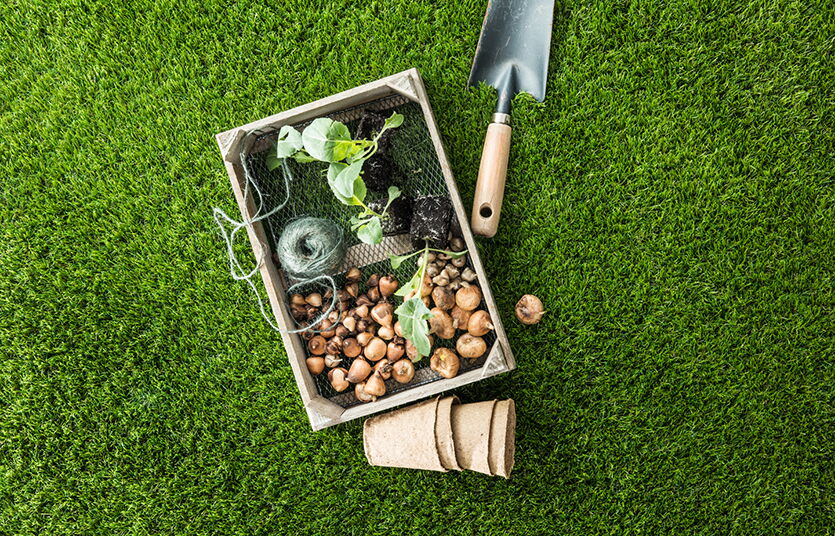Let us fill you in on infill
Artificial grass requires less maintenance than natural grass, as many know already. To maximize the output of your newly installed artificial grass, you need to keep some things in mind. In ‘Why ask a professional to install Turfgrass artificial grass’, we explain already why you should ask a professional to install your artificial lawn. The professional installer will not hesitate to use infill in your artificial grass, but you might ask yourself why this extra investment is really necessary. Trust us, it really is. You will come to the same conclusion once you’ve read this blog post…

What is infill?
Infill is a substance that is dispersed over a newly installed artificial grass lawn to fill in the space between the grass blades. Of course, the type of infill that should be used, depends on the purpose of the artificial grass. For example, rubber infill is mostly used in sports and walnut shell infill is used for its cooling properties in sunny areas.
Turfgrass recommends using washed and dried rounded silica sand for landscaping projects. Silica sand is very fine sand that has been dried in an oven to remove the moisture. Turfgrass applies the following specifics: 8 – 10 kg/m², dia 0,8 – 1,2 mm (depending on the pile height). When a professional installer has received your approval for applying silica sand, it is brushed into your artificial lawn. The tiny grains of sand sink to the bottom of the artificial grass carpet and come to rest on the PU backing. This ensures that it is not visible from above.
Why is infill necessary?
Infill keeps the artificial grass in place
Infill weighs down the artificial grass, which results in less need for other fixations. This looks better and also saves you the money for the extra fixations. Infill acts as extra ballast and this will also help the artificial grass to keep to the contour of your lawn. Artificial grass can sometimes shrink a little bit when exposed to extreme cold and it can expand when it’s very hot. When infill is applied to your artificial lawn, this is kept to a minimum. The turf is stabilized by the weight of the infill.
The grass fibers are supported by the infill
If you decide not to use infill, probably regret it. Sure, newly installed and brushed artificial grass looks perfect. But after a while, you will notice that the grass starts to look fatigued and lays down more. This is caused by the fact that most artificial grass varieties exist partly out of PE fibers. PE is, chemically speaking, a ‘lazy’ fiber. It needs more resilient materials to hold it up. This is already partly done by thatch yarn, but can be perfected by adding infill. Without infill it’s just a matter of time, depending on the pile height of your artificial grass, the weather conditions and the footfall, when your artificial grass eventually will lay down.
When infill is used during the installation, the bending point of grass blades becomes more variable, which diminishes the fatigue effect. The grass blades are supported by the surrounding substance, improving the resilience of your artificial grass.
Cooler grass
Artificial grass can get a little bit too warm in summer when the sun is pointed directly at it. When silica sand is used as infill, this can help cooling down the grass. It feels much nicer to touch!
Extra protection for the backing
Infill also protects the backing system of your artificial grass. The PU backing that Turfgrass uses on all its products is extremely durable. However, infill functions as an additional internal support structure. The backing is thus further protected from foot traffic and UV radiation. This can only add to the life expectancy of your artificial lawn.
Better fire resistance
Sand infill has another great benefit: it improves the fire resistance of your grass. The silica sand does not burn and thus lessens the effect of fire on the grass fibers.
Improved drainage
Of course, our PU backing is already provided with a drainage system in case of heavy rainfall. But did you know that silica sand can act as an extra filter within your artificial grass? This filter regulates the water flow and slows it down. Because of this, the soil underneath your artificial grass can better cope with the water.
No static electricity
Artificial grass can sometimes have a static electrical charge. This is unpleasant, especially for children who are playing on the grass. By adding sand infill to your artificial grass lawn, this problem is completely tackled.
When you sum up all the different benefits of infill, it becomes clear that it is indispensable to your artificial grass lawn. Don’t look at it as an extra cost, but as an investment that will allow you to enjoy your artificial lawn for longer.